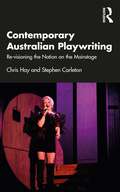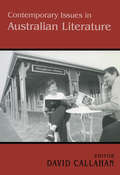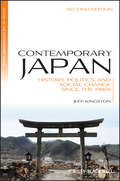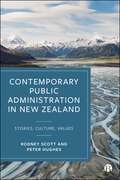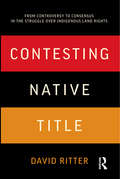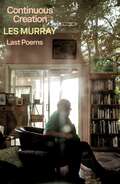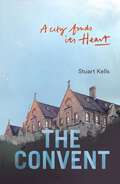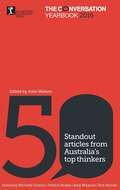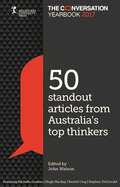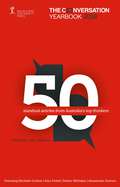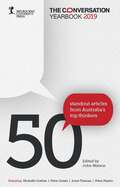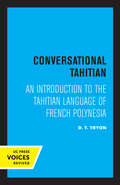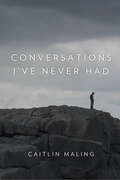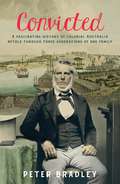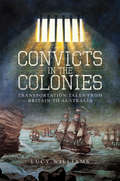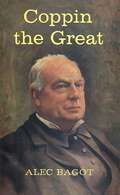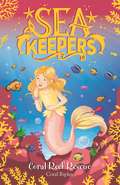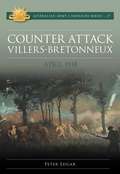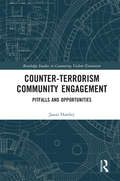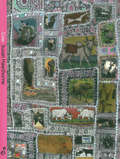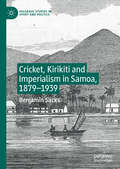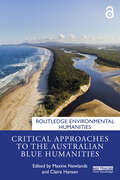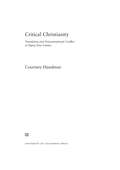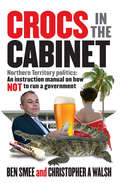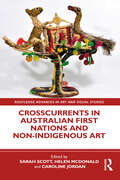- Table View
- List View
Contemporary Australian Playwriting: Re-visioning the Nation on the Mainstage
by Stephen Carleton Chris HayContemporary Australian Playwriting provides a thorough and accessible overview of the diverse and exciting new directions that Australian Playwriting is taking in the twenty-first century. In 2007, the most produced playwright on the Australian mainstage was William Shakespeare. In 2019, the most produced playwright on the Australian mainstage was Nakkiah Lui, a Gamilaroi and Torres Strait Islander woman. This book explores what has happened both on stage and off to generate this remarkable change. As writers of colour, queer writers, and gender diverse writers are produced on the mainstage in larger numbers, they bring new critical directions to the twenty-first century Australian stage. At a politically turbulent time when national identity is fractured, this book examines the ways in which Australia’s leading playwrights have interrogated, problematised, and tried to make sense of the nation. Tracing contemporary trends, the book takes a thematic approach to the re-evaluation of the nation that is dramatized in key Australian plays. Each chapter is accompanied by a duologue between two of the playwrights whose work has been analysed, to provide a dual perspective of theory and practice.
Contemporary Issues in Australian Literature: International Perspectives
by David CallahanThe contemporary study of Australian literature ranges widely across issues of general cultural studies, the politics of identity (both ethnic and gendered), and the position of Australia within wider postcolonial contexts. This volume intervenes in the most significant of issues in these areas from a variety of international perspectives.
Contemporary Japan: History, Politics, and Social Change since the 1980s (Blackwell History of the Contemporary World #15)
by Jeff KingstonThe second edition of this comprehensive study of recent Japanese history now includes the author's expert assessment of the effects of the earthquake and tsunami, including the political and environmental consequences of the Fukushima reactor meltdown. Fully updated to include a detailed assessment of the aftermath of the March 2011 earthquake and tsunami Shows how the nuclear crisis at Fukushima was an accident waiting to happen Includes detailed discussion of Japan's energy policy, now in flux after the mishandling of the Fukushima crisis Analyzes Japan's 'Lost Decades', why jobs and families are less stable, environmental policies, immigration, the aging society, the US alliance, the imperial family, and the 'yakuza' criminal gangs Authoritative coverage of Japanese history over the last two decades, one of the country's most tumultuous periods
Contemporary Public Administration in New Zealand: Stories, Culture, Values
by Peter Hughes Rodney ScottThis book provides an up-to-date account of New Zealand public administration, including insider stories of leading reform. Hailed for its distinctiveness and high performance, New Zealand’s radical public service reforms of the 1980s were studied, praised, criticised, and emulated around the world. However, New Zealand has not stood still. The 80s model had tremendous strengths, reducing some problems but also creating new problems and exacerbating others. More recent reforms layered cultural and behavioural approaches on top of earlier changes. This book, co-authored by the former head of the New Zealand public service, describes decades of change, what worked, what didn’t, and what challenges remain.
Contesting Native Title: From controversy to consensus in the struggle over Indigenous land rights
by David Ritter'This book debunks in spectacular fashion some of the most treasured, over-inflated claims of the benefits of native title.'Professor Mick Dodson, ANU Centre for Indigenous Studies'David Ritter's fascinating account of the evolution of the native title system is elegant and incisive, scholarly and sceptical; above all, unfailingly intelligent.'Professor Robert Manne, La Trobe University'An unsentimental, richly informed account of a fascinating period in the history of Australia's relationships with its indigenous people.' From the Foreword by Chief Justice Robert FrenchAfter the historic Mabo judgement in 1992, Aboriginal communities had high hopes of obtaining land rights around Australia. What followed is a dramatic story of hard-fought contests over land, resources, money and power, yielding many frustrations and mixed outcomes. Based on extensive research, enriched by intimate experience as a lawyer and negotiator, David Ritter offers both an insider's perspective and a cool-headed and broad-ranging account of the native title system. In lucid prose Ritter examines the contributions of the players that contested and adjudicated native title: Aboriginal leaders and their communities, multinational resource companies, pastoralists, courts and tribunals, politicians and bureaucrats. His account lays bare the conflicts, compromises and conceits beneath the surface of the native title process.
Continuous Creation: Last Poems
by Les MurrayThe final collection of poems by the great Australian poet Les Murray, Continuous CreationWe bring nothing into this worldexcept our gradual abilityto create it, out of all that vanishesand all that will outlast us.In Continuous Creation, the final collection from Les Murray, the preeminent poet of modern Australia recalls moments from his youth and wryly observes the changing world, moving back and forth through time and history with characteristic curiosity and an ever-fresh commitment to capturing the rhythms of life in verse. This collection displays Murray’s miraculous ability to reinvent language in order to plant his and our reality on the page, whether he writes about the Australian landscape (“Kangaroo sleeping / ahead on the road turns out / to be twigs and leaves”) or unsold books sitting in department stores.Continuous Creation demonstrates, once more, that Murray was one of the great poets of the English language. As Joseph Brodsky said, he was, “quite simply, the one by whom the language lives.”
Convent: A City finds its Heart
by Stuart KellsWhat was behind the wall and the wire? The local people knew . . . fine courtyards . . . an old swimming pool . . . dilapidated tennis courts and a remnant garden, now wild and sprawling. The Abbotsford Convent was this haunted place, left to languish for years after the last of the Sisters of the Good Shepherd had gone. In its prime it had been a school, a refuge, a retreat, a workhouse and a prison-the single largest charitable institution in the southern hemisphere. In the late 1990s a proposed high-density development threatened the idyllic riverside location, sparking outrage in the local community and further afield. Years of protesting, negotiating and fundraising followed and the convent, now on Australia's National Heritage List, has started a new life as a vibrant centre for art and culture. The Convent: A City Finds its Heart tells the story of the site's rich history and the efforts to preserve it. It is an uplifting tale of community activism-a tangible reminder that the magic of the past can endure and what people-power can achieve.
Conversation Yearbook 2016
by John WatsonIn a year in which political discourse seemed increasingly untethered from reality, The Conversation continued to bring you analysis, commentary and research from academic experts. This clearly written collection ranges widely, from Michelle Grattan's scrupulous assessment of Malcolm Turnbull's first year as prime minister, to Amy Reichelt and Clare Collins' verdict on whether eating chocolate improves your brain function, to philosopher Patrick Stokes' thoughts on the most effective way to respond to Pauline Hanson. It demonstrates the pressing relevance of academic expertise, as well as the deep pleasure of reading people who really know what they're talking about.
Conversation Yearbook 2017: 50 articles that informed public debate
by John WatsonIn a time of heightened hostility towards experts, academics and scientists, the 2017 collection of the best Conversation articles and essays is a must-read. Articles range from a FactCheck of the claim that Indigenous Australians are the most incarcerated people on earth, to answering questions posed by curious children, to Hugh Mackay's observation that the state of the nation starts in your street. Joseph Paul Forgas writes on the surprising benefits of sadness and Stephen FitzGerald considers managing Australian foreign policy in a Chinese world. If proof were needed that academia makes an essential contribution to public debate, you'll find it in these pages. Contributors include: Michelle Grattan, Hugh Mackay, Stephen FitzGerald, Denis Muller, Joseph Paul Forgas, Thalia Anthony, Alan Collins, Rachel Ong and Eileen Baldry.
Conversation Yearbook 2018: 50 standout articles from Australia's top thinkers
by John WatsonIn an era when everyone has an opinion, we rely on facts more than ever. Australia's leading thinkers give their robust opinion on the arguments and issues that fuelled public debate in 2018. This collection of essays brings you the best of the authoritative journalism for which The Conversation is renowned. Immerse yourself in the insights of experts and navigate the key questions of our times.
Conversation Yearbook 2019: 50 Standout articles from Australia's top thinkers
by John WatsonA little bit of authority goes a long way in an opinionated world. Here Australia's most erudite thinkers share expert views on the issues that shaped the nation in 2019. The Conversation Yearbook has become an annual bestselling collection that navigates fake news and shouty views and offers a fresh perspective on the fundamental issues.
Conversational Tahitian: An Introduction to the Tahitian Language of French Polynesia
by D. T. TryonThis title is part of UC Press's Voices Revived program, which commemorates University of California Press’s mission to seek out and cultivate the brightest minds and give them voice, reach, and impact. Drawing on a backlist dating to 1893, Voices Revived makes high-quality, peer-reviewed scholarship accessible once again using print-on-demand technology. This title was originally published in 1970.
Conversations I've Never Had
by Caitlin MalingCaitlin Maling's first collection is at heart a poetry of place. Cervantes, Donnelly River, Yallingup, Fremantle, Leonora, and beyond are richly evoked in poems ranging stylistically from accomplished mature lyrics and the confessional to narratives of raw power and feeling. Restlessly questioning and frequently allusive, slipping between promise and possibility, Maling's poems are invested in the actuality of the world, exploring the landscapes of memory and the brief moment of now.
Convicted
by Peter BradleyA unique history of Australia retold through the extraordinary lives of Peter Bradley&’s three ancestors: a father, son and grandson. James Bradley was a First Fleet convict found guilty of stealing a white linen handkerchief worth two shillings, and sentenced to seven years transportation to Australia. Joseph Bradley worked his life in the most dangerous occupation of the time – whaling – and despite his parents being uneducated and illiterate went on to write a journal about his experiences, rich in history and insight. Roland Bradley was a man of unionism and politics, and like his father and grandfather took up the fight against the rich and powerful through his involvement with the early Maritime union. In 1894, he wrote an account of surviving the shipwreck of the SS Kanahooka, which forced its inhabitants to wander the wilderness of North Queensland for 18 days. Following the early struggles of a fledgling colony to nationhood, Convicted is an engrossing and highly imaginative retelling of the story of one family, entwined with the history of this country from the landing of the First Fleet in 1788.
Convicts in the Colonies: Transportation Tales from Britain to Australia
by Lucy Williams&“A book that looks deeply into the lives of some of the convicts who were sentenced in court to be transported to Botany Bay.&” —Pirates and Privateers In the eighty years between 1787 and 1868 more than 160,000 men, women and children convicted of everything from picking pockets to murder were sentenced to be transported beyond the seas. These convicts were destined to serve out their sentences in the empires most remote colony: Australia. Through vivid real-life case studies and famous tales of the exceptional and extraordinary, Convicts in the Colonies narrates the history of convict transportation to Australia—from the first to the final fleet. Using the latest original research, Convicts in the Colonies reveals a fascinating century-long history of British convicts unlike any other. Covering everything from crime and sentencing in Britain and the perilous voyage to Australia, to life in each of the three main penal colonies—New South Wales, Van Diemen&’s Land, and Western Australia—this book charts the lives and experiences of the men and women who crossed the world and underwent one of the most extraordinary punishments in history. &“An easily read, fascinating history, telling the tales of the &‘recidivist&’ convicts in the 18th and 19th centuries.&” —The Essex Family Historian
Coppin the Great: Father of the Australian Theatre
by Alec BagotGeorge Seith Coppin (1819-1906), known as 'father of the Australian Theatre', a 'low comedian', was also impresario, adventurer, politician and philanthropist. This biography is based mainly on material made available by the late Miss Lucy Coppin: her father's books, journals, biographical notes, press cut-tings, playbills, and Coppin's personal letters. From an early age he acted with his parents in a troupe of strolling players in England and the colour-and uncertainties-of this life are vividly described. At 16 he chose in-dependence and appearances in provincial England, London, and Ireland followed. In 1842, accompanied by an American actress, he migrated to Australia where, in tours of the separate colonies, George's acumen gave them starring roles and excellent receipts. As well as acting and managing, Coppin pro-moted such ventures as a zoo, roller skating, hot sea-water baths and a railway line. He was a devoted husband and parent and his philanthropic activities were legion. Twice elected to the Victorian Legislative Council, in 1858 and 1889, Coppin was also a member of the Legislative Assembly for nine years 1874 to 1889, with a break 1877-1883. He built six theatres, including one pre-fabricated in England. He made three for-tunes and lost two, restoring them through stage tours. He toured the Victorian gold-fields and New Zealand and, later, with Charles and Ellen Kean, America. This visit coincided with a presidential election and the assassination of President Lincoln.
Coral Reef Rescue: Book 3 (Sea Keepers #3)
by Coral RipleyThe show must go on! The Sea Keepers head Down Under for a tropical talent show in this magical new series about saving our oceans.The Sea Keepers are off to Australia to help the Oceania mermaids! Divers are threatening their beautiful coral reef and evil siren Effluvia has enchanted a dangerous shark to spoil the mermaids' tropical talent show. Now all the fish who live there are in danger! Can Emily, Grace and Layla find a magical pearl to save the show and protect the reef without becoming a shark's snack?
Counter Attack Villers-Bretonneux: April 1918 (Australian Army Campaigns #27)
by Peter EdgarThe brutal 1914 German invasion of Belgium and France had gained a large portion of both countries. Over three-and-a-half punishing years the Allies were slowly pushing the Germans back but in March 1918, Germany launched a massive spring offensive. Resting in the Ypres sector after the horrors of the Passchendaele campaign, the Australians were among the first sent south to try to block the enemy. Now, after an unprecedented fortnight of advance, Germany’s goal was to capture the town of Villers-Bretonneux, key to the major rail junction of Amiens. The first attempt on 4 April found the 9th Australian Infantry Brigade in the centre of the line. They stopped the enemy at the gates. Then on 24 April the Germans launched a new attack, led by tanks, and took the town. Standing by to counter-attack were the 15th and 13th brigades of the Australian Corps. Not everything went to plan and casualties were high, but the counter-attack was brilliantly executed in spite of the odds. It became ‘a soldier’s fight’ in which the Australian troops’ morale and eagerness to get to grips with the enemy, together with their aggressive, well-practised moves under fire triumphed. Counter Attack: Villers-Bretonneux – April 1918 details the pivotal role the Australians played in denying German victory. Villers-Bretonneux was never again threatened by the enemy.
Counter-Terrorism Community Engagement: Pitfalls and Opportunities (Routledge Studies in Countering Violent Extremism)
by Jason HartleyThis book offers insights into the building of trust in Muslim communities through community engagement in a climate of counter-terrorism. Police engagement with Muslim communities is complex with a history of distrust. This book first attempts to understand the role and implications of uncertainty on community engagement in Muslim communities, and then explores the cultural nuances associated with the demonstration of trustworthiness, and decisions to bestow trust. It further highlights the complexities and implications for Muslim leaders when trying to simultaneously engage police and appease their own communities; the book exposes community perceptions of an over-reaction by authorities that has moved suspicion from a handful of terrorists to the entire Muslim community, resulting in problematic community perceptions that Muslim communities are being targeted by police. The findings suggest that the intentionality of police is a highly significant consideration in trust negotiations, and reveals a number of cultural preferences considered critical to trust negotiations. The book further highlights opportunities to enhance the development of trust and avoid pitfalls that can be problematic to community engagement. The lessons learned seek to enhance the existing body of literature regarding strategies and resources to improve counter-terrorism community engagement with Muslim communities. This book will be of much interest to students of counter-terrorism, preventing violent extremism, deradicalization, and security studies.
Cow
by Susan HawthorneAn intriguing approach to the rewriting of myth, this poetry collection journeys through the history of languages and symbolic traditions. Through main character Queenie, a cow of many abilities, these poems delve into the creation of the universe as Queenie fashions the galaxies and travels through the sky as a herd of stars. Delightful and surprising, this compilation draws on the Greek lyric tradition of Sappho as well as on South India's Sangam poetry tradition to provide a balanced work of both humor and melancholy.
Cricket, Kirikiti and Imperialism in Samoa, 1879–1939 (Palgrave Studies in Sport and Politics)
by Benjamin SacksThis book considers how Samoans embraced and reshaped the English game of cricket, recasting it as a distinctively Samoan pastime, kirikiti. Starting with cricket’s introduction to the islands in 1879, it uses both cricket and kirikiti to trace six decades of contest between and within the categories of ‘colonisers’ and ‘colonised.’ How and why did Samoans adapt and appropriate the imperial game? How did officials, missionaries, colonists, soldiers and those with mixed foreign and Samoan heritage understand and respond to the real and symbolic challenges kirikiti presented? And how did Samoans use both games to navigate foreign colonialism(s)? By investigating these questions, Benjamin Sacks suggests alternative frameworks for conceptualising sporting transfer and adoption, and advances understandings of how power, politics and identity were manifested through sport, in Samoa and across the globe.
Critical Approaches to the Australian Blue Humanities (ISSN)
by Claire Hansen Maxine NewlandsThis interdisciplinary edited collection explores and analyses the field of the blue humanities through an Australian lens. The blue humanities is a way of understanding humanity’s relationship with water and manifestations of what is referred to as the ‘blue’ – reefs, oceans, rivers, creeks, basins, and inland bodies of water.In its scope, this collection emphasises both the importance of the local and the interconnectedness of Australia with global environmental concerns. It considers how we conceptualise watery spaces and shades of blue in a country where water is often marked by its absence, its ephemerality, its politicisation, and its dangers. Contributors from environmental history, environmental social science, political science, literary studies, creative arts, Indigenous Knowledge, education, and anthropology tackle various entanglements between the human, the more-than-human, and watery Australian spaces in modern culture. It is the first volume to offer a specific, dedicated focus on the intersections between Australian space and the blue humanities, and it offers a pathway for those wishing to explore, critique, and advance ideas around the blue humanities in both research and teaching.Directly contributing to a growing interdisciplinary field, this is the first book to comprehensively examine the blue in Australia, appealing to scholars, educators, and students working across the humanities and social sciences with an interest in the environmental humanities, ecopolitics, ecocriticism, the blue humanities, cultural geography, environmental history, and the role of place.Chapter 2 of this book is freely available as a downloadable Open Access PDF at http://www.taylorfrancis.com under a Creative Commons Attribution-Non Commercial-No Derivatives (CC-BY-NC-ND) 4.0 license.
Critical Christianity: Translation and Denominational Conflict in Papua New Guinea
by Courtney HandmanIn Critical Christianity, Courtney Handman analyzes the complex and conflicting forms of sociality that Guhu-Samane Christians of rural Papua New Guinea privilege and celebrate as "the body of Christ. ” Within Guhu-Samane churches, processes of denominational schism-long relegated to the secular study of politics or identity-are moments of critique through which Christians constitute themselves and their social worlds. Far from being a practice of individualism, Protestantism offers local people ways to make social groups sacred units of critique. Bible translation, produced by members of the Summer Institute of Linguistics, is a crucial resource for these critical projects of religious formation. From early interaction with German Lutheran missionaries to engagements with the Summer Institute of Linguistics to the contemporary moment of conflict, Handman presents some of the many models of Christian sociality that are debated among Guhu-Samane Christians. Central to the study are Handman's rich analyses of the media through which this critical Christian sociality is practiced, including language, sound, bodily movement, and everyday objects. This original and thought-provoking book is essential reading for students and scholars of anthropology and religious studies.
Crocs in The Cabinet: Northern Territory politics an instruction manual on how NOT to run a government
by Ben Smee Christopher A. WalshGoings-on in Northern Territory politics from 2012-2016 may read like satire, but it is all true. These are stories you couldn't make up. This book is an instruction manual on how NOT to run a government.In the Top End, politics is not a numbers game, it is a blood sport.In comparison to Rudd, Gillard, Abbott and Turnbull, the goings-on in the Northern Territory parliament are like watching a troop of clowns throwing knives into each other's backs.CROCS IN THE CABINET is partly a serious political book, partly a riotous look at the characters, the scandals and the incompetence of Northern Territory politics. It will make you laugh, cry, wince and shake your head as you read of:- a minister with a hostess club bill- a masturbating minister and the lewd videos he sent someone other than his wife- why a minister shouted 'we are in love' on the floor of the parliament- how the Chief Minister stared down a coup- how an MP forced the evacuation of a hotel- why an MP went fishing instead of dealing with leadership matters- exactly how bonkers the NT parliament really is.Written by two of the NT NEWS's best journalists, Walkley Award-winning Ben Smee and award-winning Christopher A. Walsh, this is FEAR AND LOATHING ON THE CAMPAIGN TRAIL meets FAWLTY TOWERS.
Crosscurrents in Australian First Nations and Non-Indigenous Art (Routledge Advances in Art and Visual Studies)
by Sarah Scott Caroline Jordan Helen McDonaldThis edited collection examines art resulting from cross-cultural interactions between Australian First Nations and non-Indigenous people, from the British invasion to today. Focusing on themes of collaboration and dialogue, the book includes two conversations between First Nations and non-Indigenous authors and an historian’s self-reflexive account of mediating between traditional owners and an international art auction house to repatriate art. There are studies of ‘reverse appropriation‘ by early nineteenth-century Aboriginal carvers of tourist artefacts and the production of enigmatic toa. Cross-cultural dialogue is traced from the post-war period to ‘Aboriginalism’ in design and the First Nations fashion industry of today. Transculturation, conceptualism, and collaboration are contextualised in the 1980s, a pivotal decade for the growth of collaborative First Nations exhibitions. Within the current circumstances of political protest in photographic portraiture and against the mining of sacred Aboriginal land, Crosscurrents in Australian First Nations and Non-Indigenous Art testifies to the need for Australian institutions to collaborate with First Nations people more often and better. This book will appeal to students and scholars of art history, Indigenous anthropology, and museum and heritage studies.
